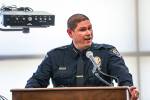Gay man relates bullying pain
Jimmy Boyer was 10 when the bullying began.
The neighborhood kids -- his former playmates -- started taunting him. They called him "homo," "pussy" and "faggot." They flicked their wrists and lisped at him.
Before long, the harassment turned physical. Boyer was forced to defend himself whenever he ventured outside.
"I got in fistfights in the middle of the street," Boyer, now 20, said. "I couldn't leave the house or I'd fight."
So he stopped leaving the house -- except to go to school, where things weren't much better.
When Boyer was a teenager, "a boy once came after me with a knife in the locker room," he said, adding that his boyfriend at the time stepped in to defend him. "The school didn't do much about it."
He even contemplated suicide.
"I was afraid to leave my house," he said. "I gained weight. I withdrew from the world."
Boyer, who was born and raised in Southern Nevada, understands the feelings of persecution and isolation that likely played a part in a string of recent suicides across the nation of teenagers who were bullied for being gay.
The suicides grabbed national attention, and one of them -- that of 18-year-old Tyler Clementi -- became a symbol in the battle against such bullying.
In September, Clementi, a freshman at Rutgers University in New Jersey, threw himself off the George Washington Bridge after a roommate allegedly used a webcam to spy on his tryst with another man.
The methods of bullying young people have evolved. "Cyber-bullies" use the Internet and other technology to torment others.
The problem certainly is not new.
"It really came into focus lately" because of advances in technology, said Ronald Lawrence, a marriage and family therapist and executive director of Community Counseling Center of Southern Nevada. "But it has always been a huge problem" both nationally and locally.
"I've seen kids quit school over it," Lawrence said. "Some kids get lost in substance abuse to numb the pain. I've had people in their 30s break down and cry over how they were treated in school. Most of the LGBT (lesbian, gay, bisexual and transgender) people we see are carrying that trauma."
Research shows gay students are much more likely to be bullied than their straight peers. Nearly nine out of 10 LGBT students have experienced harassment at school, and nearly two-thirds said they felt unsafe because of their sexual orientation, according to the 2009 National School Climate Survey of middle and high school students. The survey was conducted by the national Gay, Lesbian and Straight Education Network (GLSEN).
"Kids are using sexual orientation as a weapon," said Nathaniel Phillipps, co-chair of GLSEN's Southern Nevada chapter.
Phillipps, 19, also was raised in Southern Nevada and is openly gay but managed to get through middle and high school without experiencing much bullying aside from occasional "taunts and teasing," he said. He has heard countless stories such as Boyer's.
"I know people who have had food thrown at them in school, had their lockers graffiti-ed," Phillipps said.
Teen boys who are gay are most likely to experience bullying, Lawrence said.
"This is a time when kids form their identities," he said. "Boys who are developing their masculine identities will pick on boys who are less masculine. They get to affirm themselves as masculine."
Because the bullying occurs at such a sensitive time for boys, it is especially damaging, Lawrence said.
"It's like knives to the heart," he said. "They are trying to identify with other kids, trying to find common ground with other kids. They are often so completely rejected they just go off by themselves and are alone."
The experience often causes long-term relationship and self-esteem problems.
"They hear so often that they're not equal to other kids, that they are somehow inferior," Lawrence said. "They internalize those messages and think they are somehow less than other human beings."
Local schools "don't step in enough" to put an end to the harassment, Lawrence said.
"A lot of it is because there is just so much to deal with, so many kids, so many problems," he said.
Boyer said he didn't get enough support at school. The boy who came after him in the locker room was eventually placed back into the same classes with Boyer, he said. Teachers and administrators punished gay students more than they did straight students for displaying physical affection at school, he said.
The Clark County School District has policies against bullying "for any reason," said Michael Rodriguez, a district spokesman. "It doesn't matter what the nature of the harassment is."
Any student who bullies another would face disciplinary action, which, depending on the severity of the harassment, could range from a required parent conference to expulsion, Rodriguez said.
"We take complaints about bullying or harassment seriously," he said. "If students are not comfortable in the classroom, they're not coming to school. If they aren't coming to school, they're not getting an education."
The district's policy does not specify that harassment based on sexual orientation is forbidden. Instead, it offers a blanket statement: "Harassment, regardless of its basis, is prohibited."
Local civil rights and gay rights activists had lobbied for more specific wording when the policy was adopted in 1998.
Indeed, an earlier draft of the policy was lengthier, stating: "Harassment is prohibited regardless of whether it is based on race, color, age, creed, religion, national origin, sexual orientation, handicap, or marital or parental status, or any other basis."
A majority of school board members at the time favored the more generic language.
"Our school district is very socially conservative," said Mel Goodwin, youth and volunteer services director for The Gay and Lesbian Community Center of Southern Nevada. "Anything that has the word 'gay' in it, it's really tough. But we want all students to feel safe."
Lee Plotkin, who serves on the board of the Nevada Equal Rights Commission, was among those who argued for the more specific language at the time, saying generic language left the door open to individual prejudice and bias.
"There's a need for a policy that is inclusive of sexual orientation specifically," Plotkin said this week. "Otherwise it's left up to the teachers, administrators and employees to discern what the school board was not willing to discern. Why should a teacher go out on a limb to protect a class of students that aren't specifically pointed out?"
The district's own legal counsel suggested the more specific language at the time, Plotkin said.
"The elected officials acted contrary to legal advice," he said.
In 2002, the Washoe County School District in Northern Nevada agreed to change its policies to better protect gay and lesbian students, formally recognizing that students have a constitutional right to be open about their sexual orientation. The changes were part of a settlement with a gay former student who sued the district for discrimination and failing to protect him from harassment.
The harassment was so pervasive that the student, Derek Henkle, was forced to transfer to three different high schools to escape it, according to court documents.
Henkle, who claimed the harassment prevented him from getting his high school diploma and undermined his professional marketability, also received $451,000 in the federal civil rights lawsuit.
It's difficult to determine exactly how big a problem bullying of gay students is in the local school district, Rodriguez said. Students might not feel comfortable reporting the harassment.
"If the school isn't aware of it, there's nothing we can do," he said.
Edward Goldman, associate superintendent of education services for the district, said bullies "don't do it in front of teachers."
"The kid has to complain" in order for the school to act, he said.
Cyber-bullying has made the issue more problematic, Rodriguez said.
"The changing methods of bullying is one of the more unique challenges we face," he said. "Years ago, you didn't have access to the things online that we have now."
A student who experiences any type of bullying should immediately tell a teacher, Rodriguez said. If the student is not satisfied with how the teacher handles the issue, he or she should go to the principal.
"You want to nip it in the bud as soon as possible so it doesn't escalate," he said.
Twelve local high schools have Gay-Straight Alliance clubs for students, according to the school district. The Gay and Lesbian Community Center has two social and support groups for teens and young adults.
"There are places like this you can go," Boyer said. "You aren't alone. You have somewhere to turn. There are always people to talk to."
Students should also turn to their parents for help when possible, Lawrence said.
"Unfortunately, in many American homes that is not happening," he said. Not all parents are supportive of their gay children.
"Parents need to understand that sexual orientation is not anybody's fault," Lawrence said. "It is not evil. Parents need to tell their kids that no matter who they are, they are accepted and loved in the home. If they have that support, they can sometimes go to school and endure" bullying.
Parents who are not supportive sometimes lose their children for good, Lawrence said.
"It is always a cause of tremendous and deep sorrow for me to have to deal with the parents after the fact."
Boyer, who now attends College of Southern Nevada, considers himself lucky. The bullying stopped when he switched high schools. His family members "all came around" to the fact he is gay and are now supportive.
Remarkably, one of the neighborhood kids who bullied Boyer is now a good friend.
"He got more comfortable with me," he said. "It started when I got an iPod, and he wanted to see how it worked."
The former bully apologized for his past behavior.
"He said, 'That was dumb,' " Boyer said. "It's nice to know that people do change."
Contact reporter Lynnette Curtis at lcurtis@review
journal.com or 702-383-0285.
FOR MORE INFORMATION
Gay and Lesbian Community Center of Southern Nevada: Visit www.thecenterlv.com or call 733-9800.
Community Counseling Center of Southern Nevada: Visit www.cccofsn.org or call 369-8700.
Gay, Lesbian and Straight Education Network: Visit www.glsen.org. To contact the local chapter, send an email to glsenlv@yahoo.com.



























